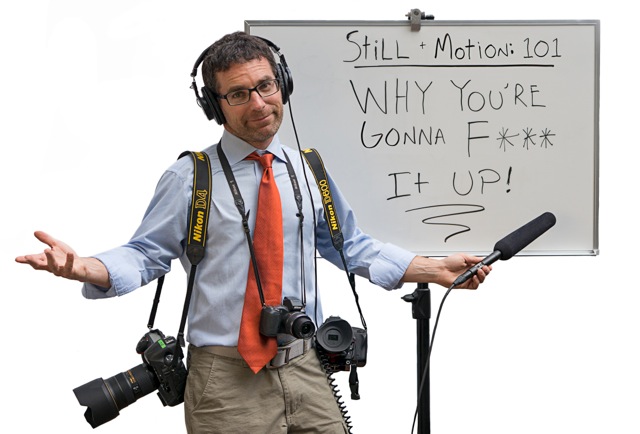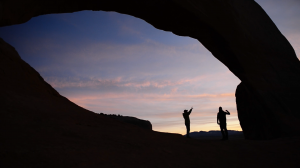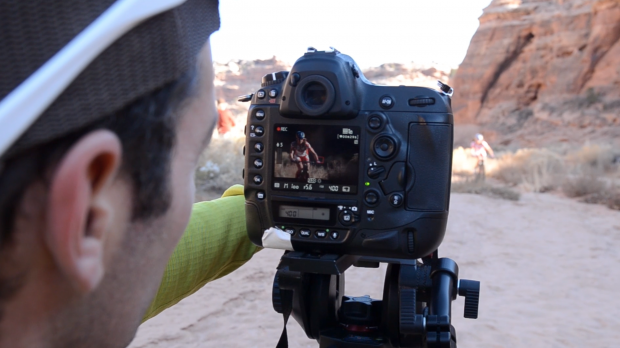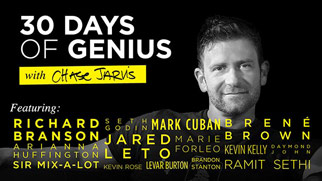I’m big-time stoked to bring to my blog a heavy hitter in the world of adventure storytelling. Corey Rich has done commercial work for everyone from Apple and Adidas to SI and Outside. He has an eagle eye for the shot, both for still and motion, and I’ve invited him here to give you all a little what-for on the topic of transition from still photography to motion film [hint: it ain’t about hitting ‘record’ and letting the talent do all the work].
Class is in session. Take it away, Corey.
 Thanks, Chase.
Thanks, Chase.
So, you’re a still photographer shooting DSLR video for the first time? No offense, but you’re about to F— It Up.
Today, storytelling, for enthusiasts and professionals alike, is all about combining your still-image and video-capturing skills into a single dynamic narrative. Clients today don’t just want amazing pictures; they want amazing pictures AND amazing videos.
“No problem!” you think. “I’m a stoked-out photographer. I could nail the focus on a moving target at 200mm f/2.8, no tripod, blindfolded! I do exposure calculations in my sleep! What’s so hard about putting my camera on a tripod, sitting back and hitting the record button?”
Well, I’m here to tell you that you’re going to blow it. You will F— It Up (FIU)!
Sorry, but it’s true.
I was one of the most seasoned adventure and outdoor-lifestyle photographers in the business. And when the groundbreaking Nikon D90 (the first video-enabled DSLR camera) came to market, it changed my life. I immediately went out and purchased one, full of doe-eyed hope that becoming a filmmaker and director would be an easy transition.
Boy, was I wrong. Sure enough, capturing stunning motion footage, with great audio, all while making dynamic photographs, was as difficult as trying to hit a Mariano Rivera curve ball with a five iron.
Through a lot trial and error, not to mention working alongside some truly great filmmakers, I’ve learned a few things. Today I have more than a few successful still-and-motion productions under my belt, and I feel comfortable juggling the roles of photographer, filmmaker, and audio tech all at once—truly a three-ring circus act.
Now I’m here today to tell you, photographer gearing up for your first still- and motion production, why you’re going to FIU. And hopefully after reading this … you won’t.
1) You’re going to run out of time.
You have a good sense for how long something should take. A trail-running shoot through morning mist? Two, three hours, tops, right? But when you add in the complexity of creating still images, capturing video and recording sound, inevitably your estimation of time will be way off. What you think will only take one hour will actually take three. By the time you’ve gotten your microphone levels adjusted, it’ll be noon and the opportunity will have evaporated along with the morning mist.
Solution: Multiply time estimates by three: If you think something will take one hour, plan on it taking three.
2) Audio? More like Audi-NO!
Hands down, audio is the single easiest thing to botch. There are a million ways that you will FIU. I know, because I’ve done them all.
/ You will forget to press the record button on the audio recorder.
/ The distant, seemingly imperceptible noise in the background—the dog barking across the street, the refrigerator’s insipid hum, the airplane passing by overhead—will reveal itself to be a port-production nightmare.
/ The levels will be completely off and will require a lot of post-production work to boost it up.
/ You will mistake watching the levels with actually listening to the audio through a set of high-quality headphones, the difference being that levels only tell you how strong a signal is, not its quality.
Though not rocket science, audio is the easiest thing to screw up.
Solution: Budget yourself enough time and pay attention to audio throughout. Otherwise, I recommend hiring an audio expert to help you out. It’ll be one less thing to worry about, allowing you to put your creative energy where you’re most comfortable: looking through the lens.
3) You’ll give assistants jobs way above their skill level.
This is probably more of a universal problem than it is necessarily specific to just shooting motion. But as photographers and directors focused on operating our cameras, we will throw our poor, hapless assistants to the wolves by putting them in charge of, say, the audio (see above). You’ll toss your assistant a set of headphones and say, “Check the audio. It’s easy.” But they don’t know what they’re listening for. And inevitably they don’t hear the incessant crinkling of the subject’s shirt through the laval mic.
Solution: Assistants … love ‘em, hate ‘em, whatever. Either way, you still have to live with them. And if they screw up something tricky like the audio (which you’d also screw up anyway), remember that they are still making your life much easier in the long run.
4) You’re not Oprah.
When you’re conducting that all-important interview with your subject, what he or she says can make or break your film. However, it’s quite challenging to be a focused, attentive camera operator AND an engaging interviewer who can draw out those important, meaningful, storytelling lines from the interview subject. Most of the time, you’ll be so focused on composition, not botching the focus, and fretting about the audio to even hear the words coming out of your subject’s mouth. Formulating that next smart interview question will be challenging, if not impossible.
Solution: Have a list of questions you want to ask your interview subject in advance. Depending on the nature of the interview, you may want to spend a few moments with your subject going over the questions and conducting a mock interview before filming the real one. Otherwise, consider bringing in a journalist/writer to conduct the interview, leaving you free to focus on operating the camera.
5) You won’t have enough extension cords.
You’re doing great so far! You’ve found a sweet location outside for your interview. The backdrop is gorgeous, and you’ve thought ahead about where the sun will be when. Further, you’ve set up two continuous light sources to ensure your subject will be well lit. You’re so smart! One problem: the closest outlet is 100 feet away, and you only have a single 20-foot extension cord.
Solution: Bring more extension cords. However, because extension cords are so heavy and bulky, I never travel with them. When I arrive on location for a shoot, I always hit up the nearest Home Depot and buy 300 feet of industrial, orange power cords. If we can return them after the shoot is over, great. If not, we make our assistant happy by giving him 300 feet of cords, which, in all likelihood, the little bastard will try to rent to us next time we come to town.
6) When it comes to High Def, beauty is NOT in the eye of the beholder.
Many guys like chicks who don’t wear make-up and are just “naturally beautiful.” Turns out, that doesn’t work in the world of video. When you’re shooting a close-up of someone’s face with a full High-Def-enabled DSLR camera, most people’s faces reveal themselves to be ruddier and rockier than the surface of Mars. On a wide high-def screen, every imperfection of skin is exacerbated tenfold. Nobody in the audience will be able to concentrate on the lines being spoken if they’re too busy cringing at every inconvenient pimple, blemish and blood vessel popping through your subject’s translucent, pale middle-aged skin.
Solution: Don’t underestimate the importance of having a makeup artist. A basic powder and touch-up kit is mandatory equipment. Learn how to apply make-up, and do your subject a favor. They may not like it at the time, but they’ll thank you later.
7) You’ll cut the clip too short.
As still photographers, capturing decisive, singular moments is ingrained in our blood. We’ll press the shutter once, and in a fraction of a second we will have made an all-but final product. Video is very different. The tendency for still photographers is to shoot for a few seconds, recompose, shoot a few more seconds of video, and so on. But, once you get back to your computer, you’ll quickly realize that short clips don’t work and severely compromise what you can do as an editor.
Solution: A good rule of thumb is to never record for less than 10 seconds. Keep that red light flashing, and make sure the camera is rolling well before and well after the action/moment is over.
8) You’ll forget you’re rolling video and recompose the camera.
Again, another tendency we still photographers have is to be constantly recomposing our shots, always thinking of dynamic new ways to capture the same scene. Video is not one decisive moment. It’s a continuous series of seconds, unfolding naturally on the screen. Footage needs continuity to be beautiful and not jarring to the viewer. You can’t move the camera once you start filming to re-adjust the composition! Sometimes you’ll start rolling, you’ll realize the composition isn’t perfect, and you’ll just have to settle for a less-than perfect composition, because that’s better than recomposing and ruining your whole clip.
Solution: Think about your composition before you hit record. Consider if your subject will be moving within the frame; shoot a bit wider so the subject doesn’t actually fall out of frame. Above all, don’t recompose your camera while filming unless you make a conscious, meaningful decision to do so.
9) You’ll shoot vertical video.
Does this even need to be addressed? Have you ever seen a vertical television?
Solution: Mount your camera horizontally, and keep it there.
10) You’ll F— up the white balance.
As still photographers, we don’t usually pay much attention to the white balance. We shoot in RAW and, thanks to Adobe and our camera manufacturers’ software, we can easily fix the white balance before processing our images.
This is the not true with video. You have to nail the white balance in camera. Also, if you’re shooting with two cameras to get two different angles of the same situation, always do a white-balance check before recording. Each camera must be set to the exact same Kelvin setting.
Solution: Again, double check that the white balance is the same for all cameras. While you’re at it, make sure both cameras are set to the same frame rate: e.g., 24 fps and full HD.
11) Your sensor will be dirty.
I know some photographers cook and eat off their camera’s sensor, leaving pizza-grade smudge marks all over their images, which they then merrily clone-stamp into oblivion in Lightroom. However, there ain’t no clone stamp with video.
Solution: Keep your sensor clean and stop eating off the damn thing!
—-
Thanks Corey! Want more? Be sure to check out Corey’s classes on CreativeLive: “Storytelling on Location” and “Action Sports Photography“. ALSO– you can watch a free lesson every day using the CreativeLive iOS apps.































15 replies on:
Motion Sickness – How Not to F- Up Your Next Photo/Video Shoot
Comments are closed.